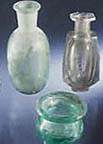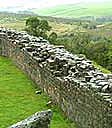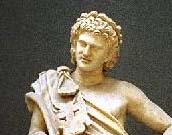 Painted or engraved bulls on the walls of paleolithic caverns suggest that from prehistoric times, the bull was associated with cosmic energy and the forces of life and death. In Anatolia, the bull was worshiped as the son of the mother-goddess, and its horns, which supported the world, were seen as the pillars of the universe.
Painted or engraved bulls on the walls of paleolithic caverns suggest that from prehistoric times, the bull was associated with cosmic energy and the forces of life and death. In Anatolia, the bull was worshiped as the son of the mother-goddess, and its horns, which supported the world, were seen as the pillars of the universe.
This concept was probably the origin of horns as a mark of divinity. In Mesopotamia, for instance, gods occasionally had bulls ears and, with almost no exception, wore a diadem with bulls horns. Another example, included in the exhibition, is the Hellenistic head of Zeus-Amon, a new Egyptian deity that emerged with the cultural fusion that followed Egypts conquest by Alexander the Great. The bulls horns that sprout from the head is again an attribute of divinity.
The Roman deity Jupiter was portrayed, like other celestial gods of Syria and Palestine, with one or two bulls. In one of the exhibitions more unusual objects, a Roman emperor is portrayed with a bulls head, a sign of the emperors divine nature.
 "Lily, rose, basil and fennel are just a few of the heady scents that once fired the imaginations of ancient Romans," said Anna Maria Ciarallo, head of biological research at Pompeii. "Finally, and based on scientific research, we can give Pompeii back some of its fragrance."
"Lily, rose, basil and fennel are just a few of the heady scents that once fired the imaginations of ancient Romans," said Anna Maria Ciarallo, head of biological research at Pompeii. "Finally, and based on scientific research, we can give Pompeii back some of its fragrance."
 An 84-mile footpath along Hadrians Wall, from Segedunum fort at Wallsend in the east to Bowness-on-Solway, west of Carlisle, is now open for visitors.
An 84-mile footpath along Hadrians Wall, from Segedunum fort at Wallsend in the east to Bowness-on-Solway, west of Carlisle, is now open for visitors.
 Charles Ortloff and Adonis Kassinos of the private company CTC/United Defense in Santa Clara, California have suggested that a series of gradient increases and decreases constructed in the aqueduct at Aspendos, Turkey were designed to prevent "slosh" and resulting damage to the ancient pipeline. They also speculated that little holes, about 3 centimetres wide, that perforate some of the pipeline's blocks, were designed to reduce turbulence in the flow by letting air and water escape.
Charles Ortloff and Adonis Kassinos of the private company CTC/United Defense in Santa Clara, California have suggested that a series of gradient increases and decreases constructed in the aqueduct at Aspendos, Turkey were designed to prevent "slosh" and resulting damage to the ancient pipeline. They also speculated that little holes, about 3 centimetres wide, that perforate some of the pipeline's blocks, were designed to reduce turbulence in the flow by letting air and water escape.
 A pair of 2,000-year-old frescoes were stolen from the "House of the Chaste Lovers" in Pompeii. The thieves hacked off a fresco of a cherub and another with a rooster pecking at an apple.
A pair of 2,000-year-old frescoes were stolen from the "House of the Chaste Lovers" in Pompeii. The thieves hacked off a fresco of a cherub and another with a rooster pecking at an apple.
 A 2,500-year-old bronze statue of a dancing satyr went on public display inside Italys parliament in Rome five years after its recovery by Sicilian fishermen. Reuters reports: "The satyr is missing both arms and one leg, but the head and torso are remarkably well-preserved despite centuries spent at the bottom of the sea. With its head tilted at a jaunty angle, curly hair flying and remaining leg suggesting it is in mid-leap, the two-meter tall satyr cuts a striking figure."
A 2,500-year-old bronze statue of a dancing satyr went on public display inside Italys parliament in Rome five years after its recovery by Sicilian fishermen. Reuters reports: "The satyr is missing both arms and one leg, but the head and torso are remarkably well-preserved despite centuries spent at the bottom of the sea. With its head tilted at a jaunty angle, curly hair flying and remaining leg suggesting it is in mid-leap, the two-meter tall satyr cuts a striking figure."